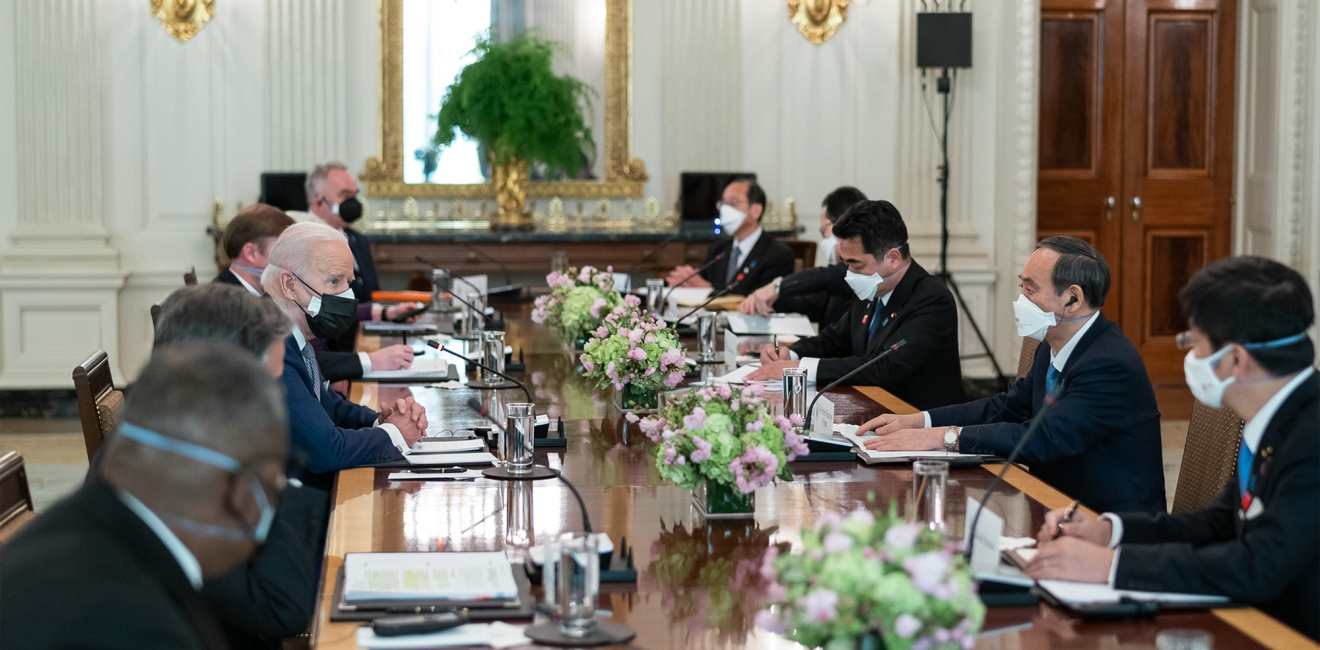
A blog of the Indo-Pacific Program
The April 16th meeting between President Joe Biden and Japanese Prime Minister Yoshihide Suga marked several milestones: not only was it the first foreign leader’s visit to the Biden White House, but it was also the first visit to the United States by Yoshihide Suga as the Japanese prime minister. It was also the first in-person summit meeting between the United States and Japan since the outbreak of a global pandemic. It marked a number of firsts in terms of content too, not least that it was the first time since the 1980s in which trade was not a sore point of contention between the two sides. Instead, trade relations projected as a way forward for further bilateral cooperation in confronting the China threat.
That isn’t to say trade relations between Japan and the United States are now smooth sailing. The U.S. trade deficit with the world’s third-largest economy runs to nearly $68 billion, and although the two sides signed a merchandise trade deal in 2019, the Japanese auto industry remains a point of contention for the United States. Indeed, Japan’s auto exports account for about $54 billion, or close to 80 percent, of the overall trade deficit. Meanwhile, the Biden administration is not expected to lift tariffs on steel and aluminum anytime soon, nor is it expected to make efforts to join the CPTPP in the near future, much to the frustration of Tokyo.
Yet instead of trying to negotiate a breakthrough on the trade front, the Biden-Suga meeting focused on bilateral economic relations based on their shared threat of dealing with China’s ambitions to challenge the regional status quo.
Yet instead of trying to negotiate a breakthrough on the trade front, the Biden-Suga meeting focused on bilateral economic relations based on their shared threat of dealing with China’s ambitions to challenge the regional status quo. Until recent months, Tokyo had aspired to maintain solid relations with China whilst furthering ties with the United States, most notably by endeavoring to decouple economic interests with Beijing from the security threat that China has increasingly been posing upon Tokyo. After the joint 2+2 joint security meeting in Tokyo in March, however, the two countries declared that China’s behavior is “inconsistent with the existing international order, presents political, economic, military, and technological challenges to the Alliance and to the international community.”
Since then, Tokyo has moved even closer to Washington publicly in pushing back against China, as the bilateral statement noted “the importance of peace and stability across the Taiwan Strait,” marking the first time since 1969 that Japan and the United States publicly referred to Taiwan which remains a core interest for China. In short, Japan’s hedging against the United States and maintaining a balancing act between China and the United States is now over. Not only is its security interests even more closely aligned with that of the United States, Japan’s economic interests are now more intertwined with that of the United States than ever.
Rather than focusing on the trade balance, Tokyo and Washington’s economic relations will concentrate more on economic resilience and maintaining free and fair economic rules of engagement in the Indo-Pacific. At the same time, the two countries are expected to work more closely together on competing against China in emerging technologies, from 5G to AI and information sciences.
For Japan, one of the biggest takeaways from the Biden-Suga meeting will be that the days of Japan posing an economic threat to the United States are now over. It will also be putting increasing pressure not only for Tokyo to be prepared to fight back against China on the economic as well as security fronts together with Washington, but it will also push Tokyo to step up its own efforts to compete in the innovation economy that goes beyond manufacturing.
Follow Shihoko Goto, deputy director for geoeconomics and senior associate for Northeast Asia, on Twitter @GotoEastAsia.
The views expressed are the author's alone, and do not represent the views of the U.S. Government or the Wilson Center. Copyright 2020, Asia Program. All rights reserved.
Author


Indo-Pacific Program
The Indo-Pacific Program promotes policy debate and intellectual discussions on US interests in the Asia-Pacific as well as political, economic, security, and social issues relating to the world’s most populous and economically dynamic region. Read more





